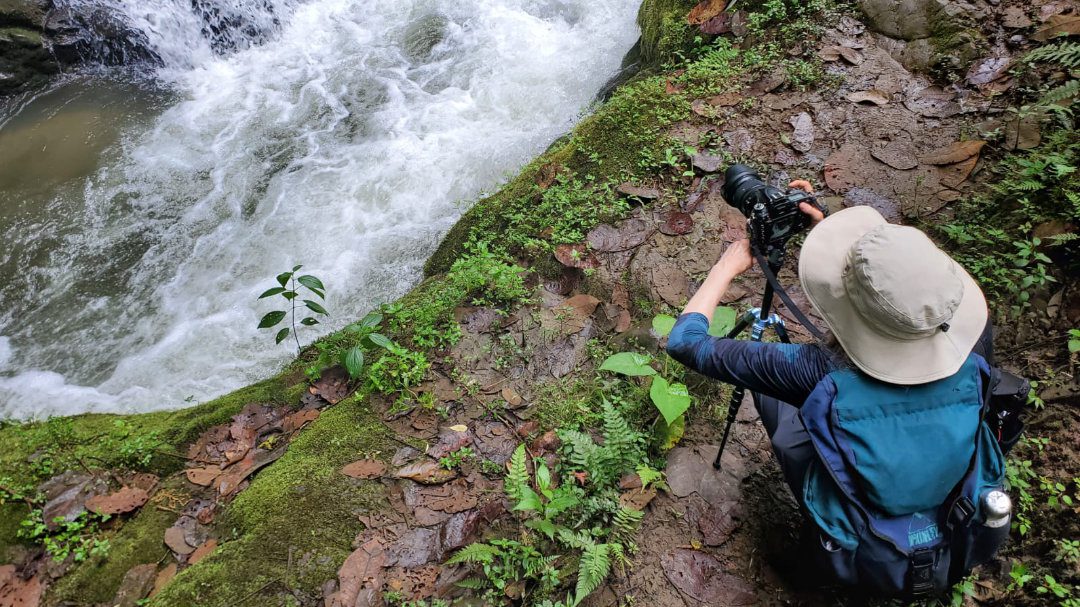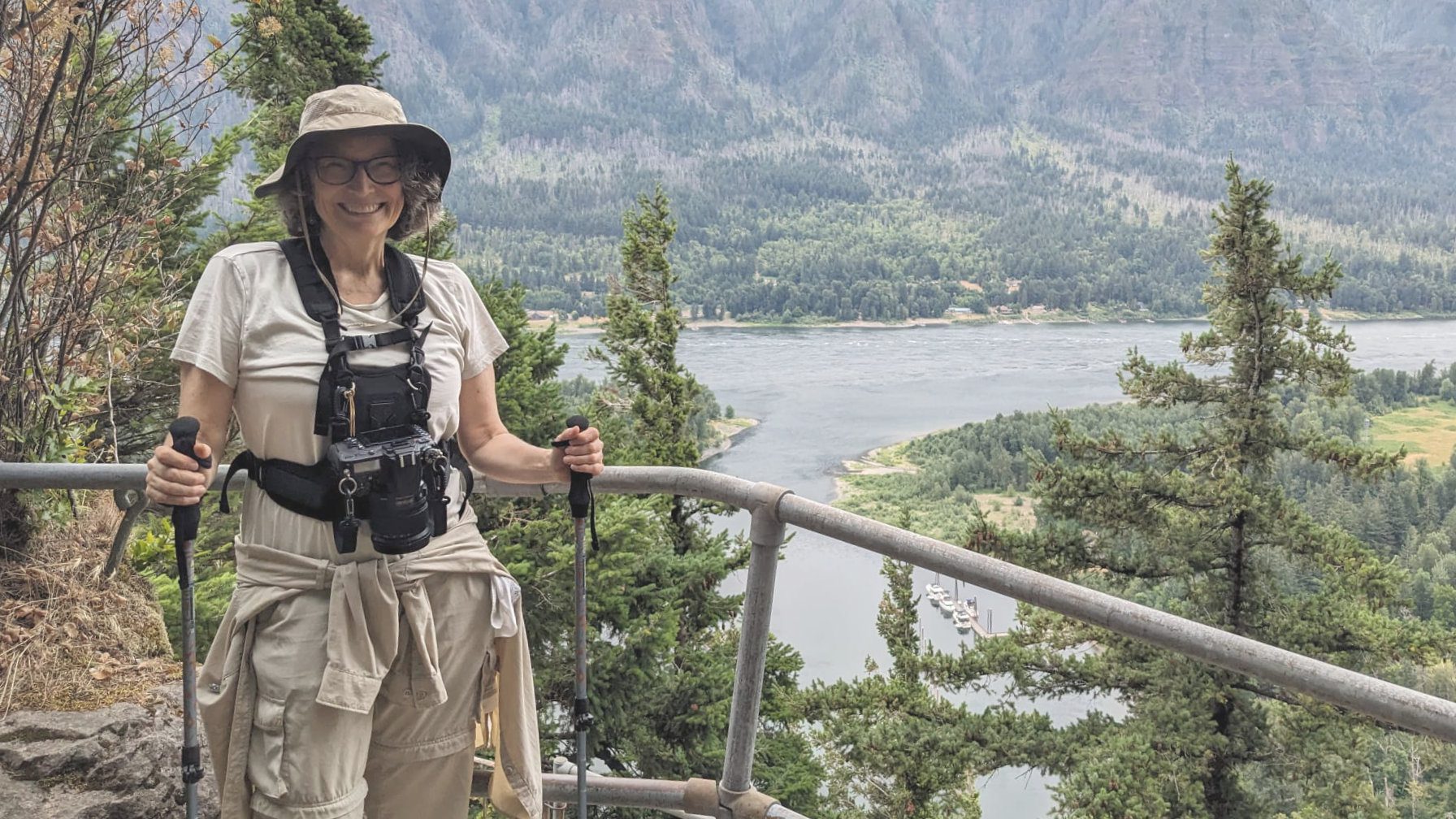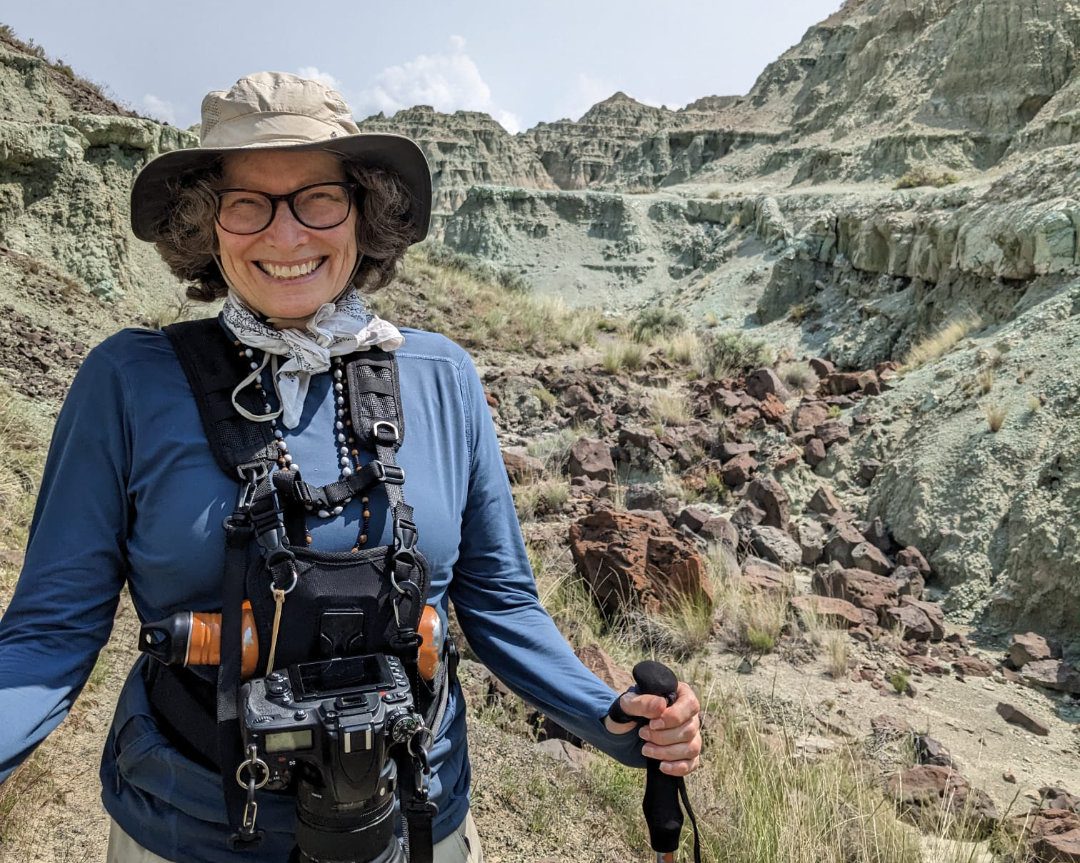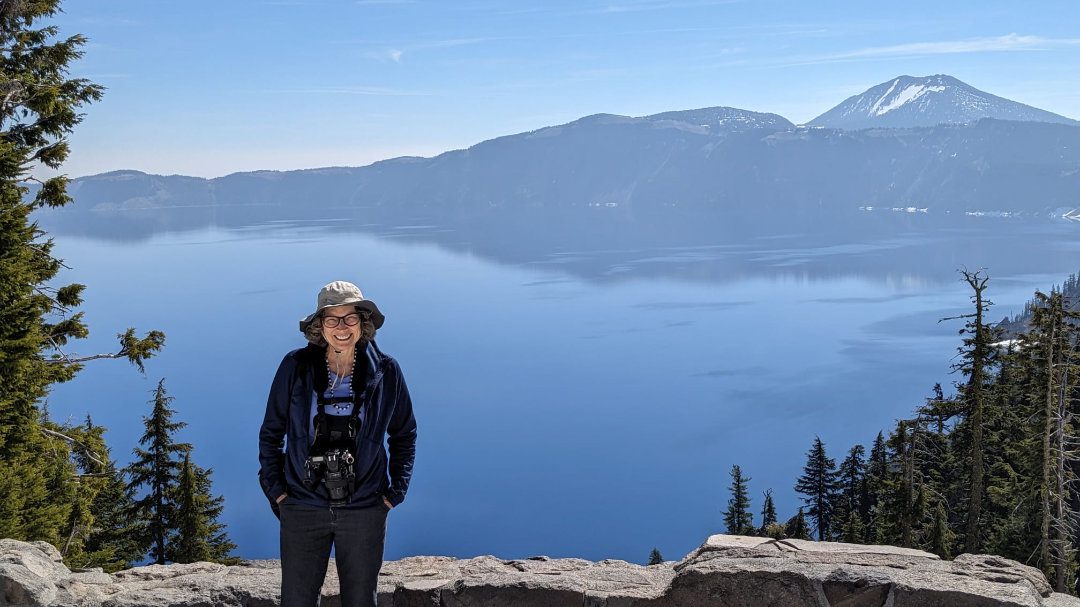No hace mucho, pensaba que mis días de excursionista habían terminado. Cuando me diagnosticaron esclerosis múltiple (EM), luchaba con mi salud de múltiples maneras, sin juego de palabras. Me costaba caminar sin cojear, el calor me quitaba la energía de una forma que no esperaba y estaba francamente deprimida. La depresión hace casi imposible planificar una excursión. Sobre todo cuando no sabes cómo levantarte y afrontar el día siguiente.
Por eso, cuando escribo estos consejos para caminar con EM, lo hago desde la comprensión. Sé que la enfermedad autoinmune de cada persona se presenta de forma diferente. Puede que mis sugerencias no te sirvan. Sin embargo, ¡espero que lo hagan!
Consejo nº 1 – Establezca objetivos manejables
Cuando empecé a enfrentarme a la esclerosis múltiple, me veía luchando contra mi propio cuerpo. Al igual que muchos estadounidenses, me educaron en la creencia de que si no hay dolor, no hay beneficio en lo que respecta a la salud física. Así que superar mis límites formaba parte de mi vocabulario de entrenamiento. No sabía que en realidad estaba dificultando el trabajo de mi cuerpo.
Cuando tenemos EM, nuestro cuerpo quiere hacer ejercicio, pero sólo en pequeñas dosis, sobre todo cuando intentamos aprender a controlar los síntomas. Tenemos que aprender a ser amables con nosotros mismos.
Para mí, eso significaba establecer objetivos manejables. Durante un tiempo, significó dejar de lado excursiones como el sendero del borde del cráter de Laguna Quilotoa y sustituirlas por opciones más cortas y menos agotadoras. ¿Quizá la ruta del jardín de colibríes en Yanachocha en su lugar? O, en mis peores días, un paseo alrededor de la manzana. He aprendido a encontrarme conmigo misma donde estoy.
También he aprendido a añadir dificultad en bocados manejables. Si sólo soy capaz de dar una vuelta a la manzana, intento hacerlo todos los días. Poco a poco, puedo añadir distancia. O puedo añadir dificultad introduciendo cuestas. Pero rara vez mi cuerpo reacciona bien si añado ambas cosas al mismo tiempo.
Hoy en día, puedo caminar unos 5 o 6 kilómetros de vez en cuando durante el fin de semana y doy paseos diarios por mi barrio. Esos paseos diarios pueden ser de media milla a dos millas, dependiendo de mi horario. Me siento cómodo superando mis límites de vez en cuando, sobre todo si el tiempo es suave y sigo mi régimen de estiramientos.

Consejo nº 2: estire los músculos
Lo mejor que hice para aliviar mi esclerosis múltiple fue empezar un régimen de estiramientos. Me ayuda a caminar mejor. De hecho, me ayuda a gestionar mejor mi vida diaria. Hay dos tipos diferentes de estiramientos que te recomiendo si quieres añadir el senderismo a tu lista de actividades.
En primer lugar, haz de los estiramientos un hábito diario. Empecé con un sencillo manual ilustrado disponible a través de la National MS Society. Al principio, documentaba cuánto tiempo pasaba con el objetivo de estirar 20 minutos cada día.
Con el tiempo, esas breves sesiones de estiramientos hicieron que mi cuerpo quisiera más. Introduje el Yin Yoga(enlace afiliado), una forma de yoga que se centra en la fascia del cuerpo. Esta escuela de yoga relativamente nueva fomenta la relajación profunda utilizando herramientas como almohadones, mantas y otros soportes(enlace de afiliado) que permiten que el cuerpo se relaje de verdad en posturas diseñadas para aflojar los músculos más tensos del cuerpo.
Para muchas personas con trastornos autoinmunitarios, nuestros músculos suelen estar en alerta máxima y se acalambran con facilidad. Cuando la fascia está bien estirada, a nuestros músculos les resulta más fácil relajarse. Los nudos y adherencias comunes a muchos trastornos autoinmunitarios empiezan a desaparecer con la práctica constante.
Si bien es posible que nunca me deshaga de todas las zonas problemáticas, definitivamente puedo sentir una diferencia en mi cuerpo. Esto es especialmente cierto en mis caderas. Y unas caderas sanas son esenciales para un senderismo saludable.
En segundo lugar, ¡estira después de la caminata! Especialmente en esos días en los que te esfuerzas un poco más de lo habitual. Tal vez era un día montañoso. Tus pantorrillas y glúteos se ejercitaron más de lo habitual. ¡Estira! Tal vez haya sido más distancia y te empiecen a doler los tobillos y los pies. ¡Estira!
Escuche a tu cuerpo y diríjete a los músculos que más se han ejercitado. Tómate entre 10 y 20 minutos para estirarlas, aunque sea unas horas después de haber salido de excursión. Tu cuerpo te lo agradecerá.
Consejo nº 3 – Utilice bastones de senderismo
Cuando era más joven, utilizaba bastones de senderismo en mis excursiones más agotadoras, sobre todo en las que tenían subidas o bajadas pronunciadas. Luego, cuando se rompieron, nunca los sustituí. Pensé que podría prescindir de él.
Luego, hace unos dos años, una amiga me propuso retomarlos. Le estaba explicando lo frustrado que estaba de excursión. Mi marido se daba la vuelta en el sendero para ayudarme a subir y bajar mucho más a menudo de lo que me gustaba. Pero tenía una buena razón. Era evidente que no tenía equilibrio y me mostraba inseguro ante el más mínimo cambio de elevación.
Me avergüenza decir que tardé meses en seguir su consejo. Sin embargo, una vez que lo hice, nunca miré atrás.
Los bastones de senderismo me ayudan a mantener el equilibrio. Me han dado una renovada sensación de confianza en el camino. Me ayudan a caminar más rápido, lo que, a su vez, me hace más fuerte con el tiempo.
Me ayudan en las subidas. Utilizo la altura más corta de los bastones que me permite plantar unos centímetros delante y al lado de donde aterrizarán mis pies y empujar hacia atrás sobre mis bastones al avanzar. Este movimiento es similar al esquí de fondo.
También me ayudan en las bajadas. Utilizo una longitud mayor, coloco los bastones delante y a los lados de donde van a aterrizar mis pies y los utilizo como frenos para ayudar a controlar mi impulso hacia delante sin tener que detenerme realmente.
Recomiendo encarecidamente usar bastones ligeros y plegables que puedas ajustar rápida y fácilmente en el camino(enlace de afiliado). Nunca volveré a estar sin ellos.

Consejo nº 4 – Hidrátese
Sé que este consejo suena muy básico. Por supuesto, los excursionistas deben hidratarse. Pero para los excursionistas con esclerosis múltiple es aún más importante hidratarse. Esto se debe a que los síntomas de la deshidratación pueden imitar los de la EM. De hecho, la deshidratación exacerba los síntomas de la EM. No hace falta.
En mi caso, llevo una botella de agua. Mi botella favorita es una Swell(enlace afiliado), regalo de un buen amigo. Me gusta mucho porque mantiene el agua fría fría y el agua caliente caliente. Por lo tanto, si voy de excursión en un día frío, tengo la opción de llevar infusiones. Y eso es importante porque tengo menos probabilidades de sentir sed cuando hace frío.
Algunos excursionistas prefieren las mochilas de hidratación(enlace afiliado). Pero antes de comprar uno, asegúrate de leer la siguiente sección sobre cómo mantener la calma.
Consejo nº 5 – Mantenerse fresco
Este es probablemente el más importante de todos los consejos. Muchos enfermos de esclerosis múltiple sufrimos sensibilidad al calor. De hecho, solía tener tanto miedo al calor que evitaba salir si pensaba que podría incluso sudar un poco. Afortunadamente, he superado ese punto de mi esclerosis múltiple y me da menos miedo esforzarme cuando sube la temperatura. Así es como me las arreglo.
En primer lugar, utilizo un chaleco refrigerante(enlace de afiliado). De hecho, en la mayoría de las fotos de este artículo, llevo uno puesto debajo de la ropa. Compré uno en Thermapparel, una empresa especializada en crear chalecos para los que padecemos esclerosis múltiple. Las plantillas están hechas de un gel químico que mantiene el cuerpo fresco durante unas tres horas seguidas.
En segundo lugar, siempre llevo sombrero, incluso en días sombríos. Un buen sombrero para el sol permite que nuestras cabezas transpiren (algo importante, ya que es una de las formas que tiene nuestro cuerpo de regular el calor), al tiempo que nos protege del sol. Me lo pongo cuando está nublado porque siempre es mejor llevarlo encima que dejarlo. Mis gorros de sol favoritos son de Columbia, pero hay muchas otras marcas que también los hacen(enlace de afiliado). Sólo tienes que asegurarte de buscar un ala llena, un color claro y una correa que se ajuste hacia abajo.
En tercer lugar, llevo ropa adecuada a las condiciones y me deshago rápidamente de las capas cuando empiezo a sentir calor. El problema de la sensibilidad al calor es que, una vez que empezamos a sentir calor, suele ser demasiado tarde. Es mejor empezar una excursión con un poco de frío que empezar a sudar en las primeras etapas. En caso de duda, mete esa chaqueta en la mochila o envuélvela alrededor de la cintura. Siempre puedes ponértelo más tarde si te sientes demasiado fresco.

Consejo nº 8 – Limite lo que lleva encima
Limita lo que llevas encima, dice la mujer con el equipo fotográfico atado al cuerpo. Sí, hay que tomar decisiones sensatas. Los días que no estoy al cien por cien, a veces opto por dejar de lado mi cámara profesional. O dejar atrás mi objetivo largo, que pesa mucho. Nunca es una decisión fácil.
Desde que compré mi nuevo arnés para cámara(enlace de afiliado), me resulta más fácil llevar mi cámara. Distribuye el peso de la cámara a lo largo de los hombros en lugar de en el cuello (correa normal) o en un hombro (correa lateral). Fue una compra barata que ha merecido la pena de muchas maneras. Mi cámara parece pesar menos, mis manos están libres para usar mis bastones de senderismo y mi cámara se mantiene pegada a mi cuerpo al escalar o trepar por rocas.
Como llevo un arnés para la cámara y uso un chaleco refrigerante, generalmente no llevo mochila. Sin embargo, es entonces cuando también salgo de excursión con mi marido. Él lleva los bocadillos y a veces una botella de agua para mí. Habrás notado en algunas de las fotos que mi botella de agua se desliza muy bien bajo el arnés de mi cámara.
Si quieres una mochila, considera una que sea ligera e impermeable. Mi marido recomienda encarecidamente un Zpack.
Consejo nº 7 – Hable con su médico
Por último, pero no por ello menos importante, hable con su médico.
Si tienes problemas para andar o te cuesta que tus piernas funcionen correctamente, asegúrate de tener esa conversación con tu médico. Puede pedir diferentes intervenciones, dependiendo de lo que intente conseguir para su cuerpo.
Pueden ofrecer fisioterapia. Si no lo hacen, pídelo. Un buen fisioterapeuta puede ayudarle a identificar áreas de mejora que su médico o usted mismo pueden no ver.
Por ejemplo, tras observar mi forma de andar y verme caminar, mi fisioterapeuta me dio ejercicios para fortalecer los músculos de los glúteos. No tenía ni idea de que ni siquiera los usaba para caminar. Irónicamente, acudí a ella para rehabilitación tras caerme y golpearme la rodilla. Pero tenía razón. Los ejercicios para fortalecer los glúteos me han hecho mejor excursionista en general.
Su médico también puede ofrecerle medicación para ayudar a su cerebro a comunicarse mejor con los músculos. Durante un par de años, utilicé medicación para ayudarme con esto con gran efecto. Me ayudó a sentir la pierna derecha menos pesada. Por desgracia, empecé a experimentar efectos secundarios, como dolor de espalda, así que decidí dejar de utilizarlo durante un tiempo. Pero es un medicamento al que podría volver a recurrir.
Es posible que haya un medicamento que pueda ayudarte. Recuerde preguntar a su médico: «¿Me recomienda algún medicamento para ayudarme (inserte aquí su deseo)?».
¡Feliz senderismo con EM!
Espero sinceramente que estos consejos te ayuden a convertirte en un mejor excursionista. En mi experiencia, pasar tiempo al aire libre me ayuda a controlar la depresión que conlleva luchar contra un trastorno autoinmunitario. El senderismo me hace una persona más feliz. Espero que a ti también te haga feliz.















